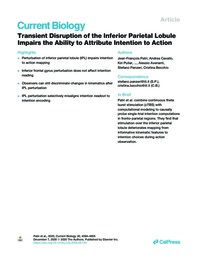Mostrar el registro sencillo de la publicación
Transient disruption of the inferior parietal lobule impairs the ability to attribute intention to action
| dc.contributor.author | Patri, Jean-François | |
| dc.contributor.author | Cavallo, Andrea | |
| dc.contributor.author | Pullar, Kiri | |
| dc.contributor.author | Soriano, Marco | |
| dc.contributor.author | Valente, Martina | |
| dc.contributor.author | Koul, Atesh | |
| dc.contributor.author | Avenanti, Alessio | |
| dc.contributor.author | Panzeri, Stefano | |
| dc.contributor.author | Becchio, Cristina | |
| dc.date.accessioned | 2021-11-18T20:18:13Z | |
| dc.date.available | 2021-11-18T20:18:13Z | |
| dc.date.issued | 2020 | |
| dc.identifier.uri | http://repositorio.ucm.cl/handle/ucm/3494 | |
| dc.description.abstract | Although it is well established that fronto-parietal regions are active during action observation, whether they play a causal role in the ability to infer others’ intentions from visual kinematics remains undetermined. In experiments reported here, we combined offline continuous theta-burst stimulation (cTBS) with computational modeling to reveal single-trial computations in the inferior parietal lobule (IPL) and inferior frontal gyrus (IFG). Participants received cTBS over the left anterior IPL and the left IFG pars orbitalis, in separate sessions, before completing an intention discrimination task (discriminate intention of observed reach-to-grasp acts) or a kinematic discrimination task (discriminate peak wrist height of the same acts) unrelated to intention. We targeted intentions-sensitive regions whose fMRI-measured activity accurately discriminated intention from the same action stimuli. We found that transient disruption of activity of the left IPL, but not the IFG, impaired the observer’s ability to judge intention from movement kinematics. Kinematic discrimination unrelated to intention, in contrast, was largely unaffected. Computational analyses revealed that IPL cTBS did not impair the ability to ‘see’ changes in movement kinematics, nor did it alter the weight given to informative versus non-informative kinematic features. Rather, it selectively impaired the ability to link variations in informative features to the correct intention. These results provide the first causal evidence that left anterior IPL maps kinematics to intentions. | es_CL |
| dc.language.iso | en | es_CL |
| dc.rights | Atribución-NoComercial-SinDerivadas 3.0 Chile | * |
| dc.rights.uri | http://creativecommons.org/licenses/by-nc-nd/3.0/cl/ | * |
| dc.source | Current Biology, 30(23), 4594-4605.e7 | es_CL |
| dc.subject | Action observation | es_CL |
| dc.subject | Intention | es_CL |
| dc.subject | Kinematics | es_CL |
| dc.subject | cTBS | es_CL |
| dc.subject | Inferior parietal lobule | es_CL |
| dc.subject | Inferior frontal gyrus | es_CL |
| dc.subject | Encoding | es_CL |
| dc.subject | Readout | es_CL |
| dc.subject | Intersection | es_CL |
| dc.subject | Single-trial analysis | es_CL |
| dc.title | Transient disruption of the inferior parietal lobule impairs the ability to attribute intention to action | es_CL |
| dc.type | Article | es_CL |
| dc.ucm.indexacion | Scopus | es_CL |
| dc.ucm.indexacion | Isi | es_CL |
| dc.ucm.doi | doi.org/10.1016/j.cub.2020.08.104 | es_CL |



